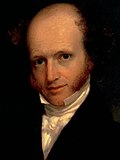Background
Martin Van Buren had been elected in 1821 to this seat, and his term would expire on March 3, 1827.
Although nominally in the same party, the Democratic-Republicans were split into two fiercely opposing factions: the "Clintonians" (allies of Governor DeWitt Clinton), and "Bucktails" (a combine of the Tammany members from New York City and Clinton's upstate adversaries led by Martin Van Buren). Both factions were divided into supporters of John Quincy Adams and Andrew Jackson, the Clintonian majority for Adams, the Bucktail majority for Jackson.
At the State election in November 1826, although Clinton was re-elected Governor, a Bucktails majority was elected to the Assembly, and eight of the ten State Senators elected were Bucktails. The 50th New York State Legislature met from January 2 to April 17, from June 27 to July 24 (Senate only), and from September 11 to December 4, 1827, at Albany, New York. The party strength in the Assembly as shown by the vote for Speaker was: 74 for Bucktail Erastus Root and 33 for Clintonian Francis Granger.
New York is a Democratic stronghold and is considered one of the "Big Three" Democratic strongholds alongside California and Illinois. The following table indicates the party of elected officials in the U.S. state of New York:
Samuel Young was an American lawyer and politician.

The 1813 United States Senate election in New York was held on February 2, 1813, by the New York State Legislature to elect a U.S. Senator to represent the State of New York in the United States Senate.

The 1819/1820 United States Senate election in New York was held on February 2, 1819, and January 8, 1820, by the New York State Legislature to elect a U.S. Senator to represent the State of New York in the United States Senate.

The 1821 United States Senate election in New York was held on February 6, 1821, by the New York State Legislature to elect a U.S. Senator to represent the State of New York in the United States Senate.

The 1825/1826 United States Senate election in New York was held on February 1, 1825, and January 14, 1826, by the New York State Legislature to elect a U.S. Senator to represent the State of New York in the United States Senate.

The 1829 United States Senate special election in New York was held on January 15, 1829, by the New York State Legislature to elect a U.S. Senator to represent the State of New York in the United States Senate.

The 1824 United States House of Representatives elections in New York were held from November 1 to 3, 1824, to elect 34 U.S. Representatives to represent the State of New York in the United States House of Representatives of the 19th United States Congress.

The 36th New York State Legislature, consisting of the New York State Senate and the New York State Assembly, met from November 3, 1812, to April 13, 1813, during the sixth year of Daniel D. Tompkins's governorship, in Albany.

The 41st New York State Legislature, consisting of the New York State Senate and the New York State Assembly, met from January 27 to April 21, 1818, during the first year of DeWitt Clinton's governorship, in Albany.

The 42nd New York State Legislature, consisting of the New York State Senate and the New York State Assembly, met from January 5 to April 13, 1819, during the second year of DeWitt Clinton's governorship, in Albany.

The 43rd New York State Legislature, consisting of the New York State Senate and the New York State Assembly, met from January 4 to April 14, 1820, during the third year of DeWitt Clinton's governorship, in Albany.

The 44th New York State Legislature, consisting of the New York State Senate and the New York State Assembly, met from November 7, 1820, to April 3, 1821, during the fourth year of DeWitt Clinton's governorship, in Albany.

The 45th New York State Legislature, consisting of the New York State Senate and the New York State Assembly, met from January 2 to April 17, 1822, during the fifth year of DeWitt Clinton's governorship, in Albany.

The 47th New York State Legislature, consisting of the New York State Senate and the New York State Assembly, met from January 6 to November 27, 1824, during the second year of Joseph C. Yates's governorship, in Albany.

The 48th New York State Legislature, consisting of the New York State Senate and the New York State Assembly, met from January 4 to April 21, 1825, during the first year of DeWitt Clinton's second tenure as Governor of New York, in Albany.

The 49th New York State Legislature, consisting of the New York State Senate and the New York State Assembly, met from January 3 to April 18, 1826, during the second year of DeWitt Clinton's second tenure as Governor of New York, in Albany.

The 50th New York State Legislature, consisting of the New York State Senate and the New York State Assembly, met from January 2 to December 4, 1827, during the third year of DeWitt Clinton's second tenure as Governor of New York, in Albany.

The 51st New York State Legislature, consisting of the New York State Senate and the New York State Assembly, met from January 1 to December 10, 1828, during the fourth year of DeWitt Clinton's second tenure as Governor of New York, and—after Clinton's death—while Nathaniel Pitcher was Governor, in Albany.

The 52nd New York State Legislature, consisting of the New York State Senate and the New York State Assembly, met from January 6 to May 5, 1829, during the short tenure of Martin Van Buren as Governor of New York, and—after Van Buren's resignation—during the first year of Enos T. Throop's governorship, in Albany.




